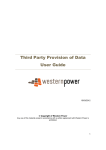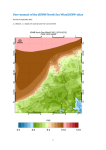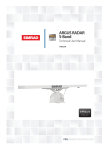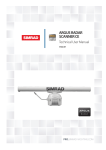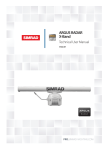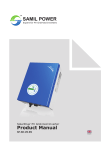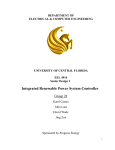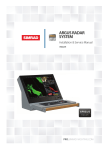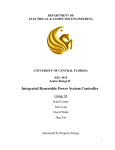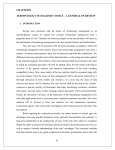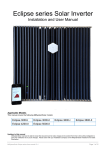Download Sunulator User Guide Sunulator User Guide
Transcript
Sunulator User Guide Alternative Technology Association August 2014 ATA’s Sunulator User Guide 2 Document Information Document Version Date Prepared By Reviewed By Comments SunulatorUserGuide1a01 27/5/14 Andrew Reddaway – Energy Analyst Damien Moyse – Energy Projects & Policy Manager Initial Draft SunulatorUserGuide1b03 10/6/14 Andrew Reddaway – Energy Analyst Damien Moyse – Energy Projects & Policy Manager Version 1 SunulatorUserGuide1c01 26/6/14 Andrew Reddaway – Energy Analyst Damien Moyse – Energy Projects & Policy Manager Updated for sign convention change – don’t have to input costs as negative numbers. SunulatorUserGuide1c02 10/6/14 Andrew Reddaway – Energy Analyst Damien Moyse – Energy Projects & Policy Manager Added a few clarifications – time zones, inflation etc. © 2014 Alternative Technology Association. All rights are reserved. No part of this report may be reproduced without acknowledgement of source. ATA Energy Projects Team Prepared by: Andrew Reddaway, Damien Moyse Alternative Technology Association Level 1, 39 Little Collins St, Melbourne VIC 3000 +61 3 9639 1500 +61 3 9639 5814 www.ata.org.au Promoting Renewable Energy, Energy Efficiency and Water Conservation since 1980 KP091 www.ata.org.au 28 August 2014 ATA’s Sunulator User Guide 3 Contents Document Information................................................................................................................. 2 1.0 Introduction ..................................................................................................................... 4 1.1 Availability ............................................................................................................................... 4 1.2 Locations ................................................................................................................................. 4 1.3 Scope ....................................................................................................................................... 4 1.4 System requirements to use Sunulator .................................................................................. 5 1.5 Time required.......................................................................................................................... 5 1.6 Who can use Sunulator? ......................................................................................................... 5 1.7 Who are we? ........................................................................................................................... 5 1.8 User Tips.................................................................................................................................. 5 1.9 Conventions ............................................................................................................................ 6 2.0 2.1 3.0 Electricity consumption ..................................................................................................... 7 Entering consumption information into Sunulator................................................................. 7 Grid tariffs ...................................................................................................................... 12 3.1 Flat rate tariffs....................................................................................................................... 12 3.2 Time of Use tariffs ................................................................................................................. 13 3.3 Anytime peak demand tariffs ............................................................................................... 14 3.4 Other kinds of tariff............................................................................................................... 16 4.0 Simulation model............................................................................................................ 17 4.1 Scenarios ............................................................................................................................... 17 4.2 Solar ...................................................................................................................................... 18 4.3 Costs ...................................................................................................................................... 20 4.4 Community options............................................................................................................... 22 4.5 Community variables ............................................................................................................ 23 4.6 Future variable changes ........................................................................................................ 25 4.7 Run model ............................................................................................................................. 27 5.0 Sunulator results............................................................................................................. 29 5.1 Quick results.......................................................................................................................... 29 5.2 Results statistics .................................................................................................................... 30 5.3 Financial Projection............................................................................................................... 34 5.4 Consumption vs Generation Charts ...................................................................................... 36 5.5 Dollar Impact Charts ............................................................................................................. 38 Appendix A – Sourcing information on electricity consumption ................................................... 39 5.6 Electricity meter data............................................................................................................ 39 5.7 Manual readings of the electricity meter ............................................................................. 39 5.8 Electricity bill ......................................................................................................................... 40 5.9 Rough Estimates.................................................................................................................... 40 5.10 Substitute data ...................................................................................................................... 40 Page 3 of 41 www.ata.org.au Saved 28/08/2014 9:44:00 AM Printed 28/08/2014 9:45:00 AM 4 ATA’s Sunulator User Guide Glossary..................................................................................................................................... 41 1.0 Introduction Sunulator is a simulation tool that can help you plan a grid-connected solar project. Unlike most other solar calculators, Sunulator uses half-hourly consumption data over a whole year to estimate how much solar generation will be consumed onsite versus exported. Based on electricity tariff information, it then calculates the impact on your electricity bill and projects the savings up to a 35-year timeframe. Financial results include payback period, net present value and Return on Investment. Sunulator allows you to compare the results for several scenarios, for example different system sizes or panel orientations. In Australia, most solar installations are owned directly by the electricity consumer, eg a home owner. Sunulator is designed to assist community organisations to install solar systems via additional investment options: • Community organisation installs a system and sells electricity to the host site. • Solar system installed via a loan from a community organisation. • Community organisation acts as an electricity retailer. Economic returns are estimated both for investors and the host site. 1.1 Availability ATA provides Sunulator free of charge for community use at www.ata.org.au/ata-research/Sunulator 1.2 Locations Since Sunulator’s development has been funded by state-specific organisations, it currently includes locations in the following Australian states and territories: - New South Wales - Victoria Sunulator can be used in other states, but a proxy location will have to be selected. As additional funding is obtained, we hope to support other states in future versions. 1.3 Scope Sunulator is for solar systems on sites connected to an electricity grid in Australia. It will not produce a detailed solar system design - that will need to be done by an accredited designer and/or installer. Billing and tariff calculations are included to assess the overall financial attractiveness of different options; they are approximate and cannot be expected to replicate calculations performed in an electricity retailer's billing system. Page 4 of 41 www.ata.org.au Saved 28/08/2014 9:44:00 AM Printed 28/08/2014 9:45:00 AM ATA’s Sunulator User Guide 1.4 5 System requirements to use Sunulator To use Sunulator, you must have: - A reasonably fast, stable computer. - Microsoft Excel 2003 or later. - System permissions to run Excel macros (VBA code). 1.5 Time required Sunulator has several inputs and decision points. Please allow at least half an hour, excluding data gathering. 1.6 Who can use Sunulator? Sunulator is focused on community solar projects, but there’s no reason it can’t also be used by businesses or households. To get the most out of Sunulator, we recommend that you have some prior skills and understanding, for example: - Confidence using Microsoft Windows Desktop (or the Apple equivalent), for example creating folders and viewing file extensions. - Have a basic understanding of energy concepts, eg kWh and kW. - Have a basic knowledge of financial concepts, eg Payback Period and Net Present Value. 1.7 Who are we? Sunulator has been developed by the Alternative Technology Association (ATA), www.ata.org.au, Australia’s leading not-for-profit organisation promoting sustainable solutions for the home. 1.8 User Tips • • • • • Yellow cells are for user entry. Cross-hatched yellow cells do not need any user entry. Other inputs have made them irrelevant. CTRL-down arrow jumps to the bottom of a filled table. CTRL-right arrow jumps to the right. o Holding down shift selects cells while it jumps. You can copy and paste within yellow cells. You can select a range, and use CTRL-D to copy down, or CTRL-R to copy right. o But not if the range spans a white cell. Page 5 of 41 www.ata.org.au Saved 28/08/2014 9:44:00 AM Printed 28/08/2014 9:45:00 AM ATA’s Sunulator User Guide 1.9 6 Conventions Please see some notes below on conventions for user entry within Sunulator 1.9.1 Time Zones Sunulator works on Australian Eastern Standard Time (AEST). This aligns with the time zone for electricity metering data, which is AEST within the National Electricity Market (NEM). So when entering times into Sunulator, please enter them as AEST. If Sunulator is expanded to cover WA and NT which are outside the NEM, provision will be made for different time zones. 1.9.2 Inflation Sunulator uses constant dollars, so there is no need to inflate future prices by the Consumer Price Index (CPI). Few prices involved in Sunulator have much relation to CPI. For example, the biggest driver of grid electricity tariffs is investment in the distribution networks, which can double in a decade then stay flat for a decade. Solar panels have been dropping dramatically over the past several years. From an investor point of view, you may want to factor CPI into the rate of return on the investment. In this case, you can add CPI onto the discount rate (see the section on costs below). Page 6 of 41 www.ata.org.au Saved 28/08/2014 9:44:00 AM Printed 28/08/2014 9:45:00 AM ATA’s Sunulator User Guide 7 2.0 Electricity consumption The economic benefit of a solar system depends on the level of electricity consumption at the site where the system is located. Solar systems are metered under a “net” basis1. This means that solar generation first goes to meet immediate onsite electricity consumption, reducing the metered import from the grid. Only the excess (if any) is recorded by the electricity meter and exported to the grid. Electricity exported to the grid typically is worth up to 8c per kWh2. This is called a Feed-in Tariff (FiT) for small/medium sized systems, or a Power Purchasing Agreement (PPA) with the energy retailer. By comparison, electricity imported from the grid might cost around 25 or 35 cents per kWh. Clearly, solar generation consumed immediately onsite is worth much more than exports. 2.1 Entering consumption information into Sunulator You need to obtain either metered consumption data, or general information about site consumption before you can enter it in Sunulator. For some tips, please see Appendix A “Sourcing information on electricity consumption”. To get up and running quickly, you can start with default data. Then come back later, refine it and re-run Sunulator. 2.1.1 Consumption Options The first worksheet under “Consumption” gives you this choice: • • Click on the yellow cell to get the drop-down list. If you have obtained detailed metering data, select option (b). Otherwise, select option (a). You also need to specify a date range. • • It is best to enter a full year, to cover different seasonal effects. If in doubt, select the most recent calendar year. 1 The exception is systems on “gross metering” contracts such as those available in NSW and the ACT for systems installed between 2009 and 2011. 2 The Feed-in Tariff can vary by state, electricity distributor, retailer and date of solar installation. Some existing systems receive a feed-in tariff higher than consumption tariff, eg the 60c Premium Feed-in Tariff previously available in Victoria, but closed to new entrants. Page 7 of 41 www.ata.org.au Saved 28/08/2014 9:44:00 AM Printed 28/08/2014 9:45:00 AM ATA’s Sunulator User Guide 2.1.2 8 Enter estimates With “Enter Estimates”, you give Sunulator some information on electricity consumption. Then when you run Sunulator, it will construct a half-hourly consumption dataset consistent with this information, for the date range you specified in the previous sheet. This worksheet lets you input the variation throughout the year. A simple option is to obtain an average monthly consumption from the last electricity bill. • Find the kWh total and divide by the number of months included in the bill. • • Click the “State” cell, and select from the drop-down list. Click each yellow cell, and type in the number. Page 8 of 41 www.ata.org.au Saved 28/08/2014 9:44:00 AM Printed 28/08/2014 9:45:00 AM ATA’s Sunulator User Guide 9 2.1.2.1 Daily Consumption Options In the next worksheet, you select how you would like to enter estimates of daily consumption. 2.1.2.2 Daily Consumption Option 1 If you selected the consumption option “Several Periods”, here you tell Sunulator how electricity consumption varies throughout a typical weekday. You may have obtained this information by manually reading the electricity meter several times per day. Please see appendix A for some tips on how to do this. Or it may simply be a rough estimate. For example, you are analysing a business and found that: • Average daily consumption is 500 kWh. • Morning shift goes from 7:00am to midday. • Morning shift consumption is 200 kWh on average. So for that period you enter 200/500 = 40%. • • • • You can change the label of each period – this may show up in reports later on. You can change the start time of each period. The end time of each period is defined by the start time of the next period. You must ensure the total is 100%. It is common for weekends and public holidays to have different consumption from normal weekdays. This worksheet is where you account for that. Page 9 of 41 www.ata.org.au Saved 28/08/2014 9:44:00 AM Printed 28/08/2014 9:45:00 AM ATA’s Sunulator User Guide • • 10 If you choose “WeekdayFactor”, you must enter a factor. o This day will have same shape as a standard weekday, but a different total. The other options are the labels you entered on the previous worksheet. o This day will have constant electricity consumption. Date ranges with low consumption There may be times of the year when consumption is abnormally low, for example business shutdowns or holidays. You can use this section to reflect this effect. • • • • Enter range of continuous dates on a separate row. Choose a label for the date range, eg “XmasMaint” Enter start and end date for the date range Select the option (and the factor if required) as for the previous table. 2.1.2.3 Daily Consumption Option 2 If you selected the consumption option “Half-hourly intervals”, you will go to this worksheet instead of the previous one. This worksheet allows you to input a weekday profile with more precision. Page 10 of 41 www.ata.org.au Saved 28/08/2014 9:44:00 AM Printed 28/08/2014 9:45:00 AM ATA’s Sunulator User Guide 11 For each of the 48 intervals: • Click on the yellow cell • Enter a percentage. You can also copy and paste from another spreadsheet. Please note that with this option, weekday and public holiday options from “Consumption option 1” still apply. For example, you may want weekends to retain the same profile, but at only 80% of the consumption. 2.1.3 Copy and paste If you have half-hourly meter data in a spreadsheet, this is the option for you. For tips on obtaining meter data, please see appendix A. It’s up to you to format your spreadsheet as follows: • First column contains a date, eg “01/01/2013” • 48 columns containing half-hourly consumption in kWh. Tip – if your raw data has a row for each half-hour interval, try using an Excel pivot table to format it into the required layout. • • Switch to your separate spreadsheet o Select the data and copy it Switch to Sunulator o Select the cell below “Date” and paste. Page 11 of 41 www.ata.org.au Saved 28/08/2014 9:44:00 AM Printed 28/08/2014 9:45:00 AM ATA’s Sunulator User Guide 12 3.0 Grid tariffs An energy tariff defines how the bill will be calculated for electricity imported from the grid. There are too many different types of tariff for Sunulator to include them all, so it focuses on the most common ones. Consumers have a choice of tariffs, to varying degrees, however customers with solar have more limited options than those without. Please note that the tariff may be changed when solar is installed – you should check this with the electricity retailer. Please note that you don’t need to fill in every tariff type in Sunulator, only the one or two which are relevant for your situation. There are some tariffs that cannot be represented perfectly in Sunulator. In this case, you will have to find the closest approximation. 3.1 Flat rate tariffs These are the most common type of tariff. If in doubt, use this tariff initially. You can always change tariffs later and re-run Sunulator. • • • • • Even if the site is importing no electricity, a fixed charge will be applied. The fixed monthly charge is intended as an alternative to the daily. If you enter both daily and monthly, they will both be applied and have a cumulative effect. So only do this if you have both monthly and daily charges. Some commercial tariffs state the fixed costs as several components – you will need to add them together for a total monthly and/or daily cost. You might need to convert some annual or quarterly charges into monthly values too. Energy charge per kWh is multiplied by the consumption in kWh to give the energy cost. Page 12 of 41 www.ata.org.au Saved 28/08/2014 9:44:00 AM Printed 28/08/2014 9:45:00 AM ATA’s Sunulator User Guide 3.2 13 Time of Use tariffs This worksheet covers tariffs where the energy charge per kWh varies throughout the day, eg: • Time of Use (ToU) • Peak/Offpeak • Flexible pricing It also covers tariffs that have a block structure, eg “inclining block”. The fixed charges section is equivalent to the one for flat rate tariffs – please see above. The Demand-based daily charge is only relevant if the retailer imposes this separately. In the “Block Categories” section, enter the different tariff categories. These may show up later in reports. For example, there may be Off-Peak, Shoulder and Peak. Retailers often set tariffs in “blocks” of import for each calendar month. For example, a business imports 500 kWh in January. The first 333 kWh are charged at 24c per kWh, then the remaining 167 kWh are charged at 28c per kWh. February starts again at 24c per kWh. A blank, open-ended block will apply for all imports exceeding the final threshold. Finally, below is the table where you enter the cost per kWh. You may need to check with the retailer what time the different categories start and end. Page 13 of 41 www.ata.org.au Saved 28/08/2014 9:44:00 AM Printed 28/08/2014 9:45:00 AM ATA’s Sunulator User Guide 14 To deal with blocks: • If block thresholds are not relevant to you, then just use the column “AllBlocks”. • If all your energy is allocated to blocks, then use columns “Block1” to “Block4”. • If some energy is in blocks and some is not, use all the columns. • • • You must enter a category and a number in each of the 48 rows. o Eg if you only have a single rate, you might enter “Single”. You can copy and paste to speed up data entry. o Click a cell. o Select “copy” from the Excel menu. o Drag-select a range of cells. o Select “paste” from the Excel menu. There is a separate table for weekends and public holidays. 3.3 Anytime peak demand tariffs At the time of writing, anytime peak demand tariffs are typically only applied to industrial and commercial customers. Anytime peak demand tariffs depend on the highest recorded half-hourly electricity demand for the site (“demand” is the retailer’s term for instantaneous power import from the grid). They may also be known as a “peak tariff” or “demand charge”. For example an Adelaide grocer’s peak demand may occur on a weekend afternoon, in a heatwave during the pre-Christmas rush. Their air conditioning is running flat-out replenishing air lost through frequently-opening doors. Peak demand may occur when a solar system is not generating. For example a sport club’s peak demand might occur during a night game while the floodlights are on. “Anytime” indicates that no times of day are excluded when finding the peak demand. Page 14 of 41 www.ata.org.au Saved 28/08/2014 9:44:00 AM Printed 28/08/2014 9:45:00 AM ATA’s Sunulator User Guide Peak tariffs are set in kilowatts (kW), which is the average power demand over the half-hour interval. For example, the grocer may have consumed 20 kWh during the peak interval. This equates to an average power demand of 40 kW for half an hour. 15 The demand charge is the annual fixed charge per kW of demand. For example, if the demand charge is $100 per kW, the retailer is charged 40 * 100 = $4,000. This charge will be spread out over subsequent bills. “Minimum Demand” is a minimum level for the demand charge. For example, the grocer may be on a tariff with a minimum demand of 50 kW. In this case, even though their actual demand was 40 kW, the demand charge is 50 * 100 = $5,000. Energy businesses have different schedules by which they reset the demand charge to take account of recent history. Sunulator finds the interval with maximum import over the entire consumption data range (typically one year). If the scenario has a solar system, Sunulator will take its generation into account, automatically reducing the demand charge if the peak demand has been reduced. Typically, anytime peak demand tariffs are not purely based on the peak demand – there is also a component that’s priced on the energy consumption. • • Enter the Minimum Demand and Demand Charge Enter the energy charges for peak and off-peak periods. This section allows you to define the start and end times for the peak period, for the energy charge. All other times will be charged at the off-peak rate. Page 15 of 41 www.ata.org.au Saved 28/08/2014 9:44:00 AM Printed 28/08/2014 9:45:00 AM ATA’s Sunulator User Guide 3.4 16 Other kinds of tariff 3.4.1 Controlled loads Some consumers have a special tariff for specified appliances or circuits, typically electric hot water systems that can only be run at off-peak times during the night. Sometimes these tariffs are just called “off-peak” tariffs. Controlled loads are metered separately from the rest of the import. Sunulator cannot represent them together with the other import in one scenario. If possible when a controlled load is separately metered, remove the controlled load consumption from Sunulator’s consumption profile, and ignore their tariff. This won’t impact the analysis when the controlled load is only used during times of little or no generation. 3.4.2 Critical peak pricing This is a type of peak demand tariff, for commercial and industrial customers. When identifying the peak demand, instead of considering the an entire year the energy business considers only five or ten specific days, for which it has given its customers pre-warning a day or two before. If you need to cover a tariff such as this, please contact the ATA as we can assist you on a project basis. As the energy industry evolves, new tariffs are still emerging. Once they are more common we plan to include them in Sunulator. Page 16 of 41 www.ata.org.au Saved 28/08/2014 9:44:00 AM Printed 28/08/2014 9:45:00 AM ATA’s Sunulator User Guide 17 4.0 Simulation model This section covers how scenarios are defined and configured, and running Sunulator. 4.1 Scenarios Most likely, you’ll have several different options you’re considering for a solar project. Eg: • Different system sizes • Roof surfaces with different orientations and tilts • Locations • Ownership options • Grid tariffs You would like to compare how the different options stack up against each other, economically and environmentally. To cater for different options like these, Sunulator allows you to define up to six scenarios at once. When you run Sunulator, all the scenarios are run separately, but the results worksheets make it easy to compare scenarios against each other. Scenario 1 should be entered as a “business as usual” scenario. Typically this has no solar system, and current tariffs. Most financial results show the difference between scenarios 2-6 and scenario 1. For example, what is the saving off the annual bill? Scenario 1 is the baseline. • • Click on a yellow cell Enter a scenario name. Page 17 of 41 www.ata.org.au Saved 28/08/2014 9:44:00 AM Printed 28/08/2014 9:45:00 AM ATA’s Sunulator User Guide 4.2 18 Solar This is where you tell Sunulator about the solar system for each scenario. Typically the first “Business as Usual” scenario doesn’t have a solar system. 4.2.1 Location Please select a location from the drop-down box. Please note that not all Australian states are supported yet, as Sunulator has been developed with funding from state-based organisations. At the time of writing, only NSW and Vic are included. Locations have been selected to cover a range of population centres and climates. Sunulator has a higher density of locations where annual sunshine varies a lot from place to place, for example, mountain ranges and the coast. Select a location close to the site you are analysing. But also take into consideration the level of sunshine at your site. A location slightly further away may be more representative than the closest one. It may help to refer to a solar map, eg http://solargis.info/doc/free-solar-radiation-maps-GHI How the location list is sorted: - Capital city locations are listed at the top. Then, - Locations are sorted by state. Then - From south to north within the state. 4.2.2 Array Capacity If your scenario has solar panels facing in two different directions (for example on different roof surfaces or tilt frames), then enter them as separate arrays in sections A and B. Otherwise you can enter them all as one array. Please enter the “nameplate” capacity of the array, ie the rated capacity at standard test conditions, in kW. A single typical solar panel has a capacity of 0.25 kW. Residential systems are typically 5 kW or smaller. At the time of writing, Sunulator does not support systems in which the inverter is under-sized compared to the array capacity. 4.2.3 Array Tilt Tilt is measured from horizontal. Typically panels are installed on the same tilt as the roof as long as it’s greater than 10 degrees. To some extent, tilts greater than 10 degrees self-clean when it rains. Page 18 of 41 www.ata.org.au Saved 28/08/2014 9:44:00 AM Printed 28/08/2014 9:45:00 AM ATA’s Sunulator User Guide 19 For southern parts of Australia, a tilt in the vicinity of 30 degrees is good to maximise total annual generation. You can verify this with Sunulator. Sunulator does not currently support arrays that move to track the sun. With current prices, such systems are rarely economic. 4.2.4 Array Orientation North orientation maximizes annual generation and environmental benefits3. However, it may not give the greatest economic return. An east-facing array will generate more on summer mornings, and west-facing on summer evenings. The value of generation at times of onsite electricity consumption may outweigh the value of extra generation that is exported to the grid. You can test this in Sunulator. You can enter a variety of abbreviations, eg “North-East, “NorthEast”, “NE” etc. Or you can enter a compass bearing, where north = 0 degrees and East = 90 degrees. Please note that Sunulator expects an orientation based on true north. This can vary from magnetic north by up to 15 degrees. For more information, google “declination map Australia”. 4.2.5 Array Efficiency Even when facing directly into full sun, your solar system will rarely deliver its rated capacity due to factors such as: - Dirt on the panels - Thermal derating (hot panels generate less) - Losses in the electrical cables and inverter In Sunulator, all such factors are allowed for in the single array efficiency number. ATA tested Sunulator against generation reported from dozens of real-world systems in different locations, and found that an efficiency of 80% generally provided a good match.4 Separate to the array efficiency, Sunulator also allows for lower generation in future years due to panel ageing. Some other solar calculators use a lower efficiency number, but this includes an allowance for ageing too. If your site suffers from shading, you will need to estimate a lower efficiency to compensate. 4.2.6 Array B If a scenario includes a second array, enter its details in the second array section. 3 4 For the southern hemisphere. Based on public data from PvOutput.org, for all of 2013, running Sunulator with 2013 insolation data. Page 19 of 41 www.ata.org.au Saved 28/08/2014 9:44:00 AM Printed 28/08/2014 9:45:00 AM ATA’s Sunulator User Guide 4.3 20 Costs Information on costs can be entered separately for each scenario. 4.3.1 Financial Assumptions These variables influence the reported financial results. - - Consumption Tariff. Select from the drop-down box. Each tariff’s settings can be changed in the section “Tariffs”. Feed-in Tariff. This is how much money or credit is received from the electricity retailer per kWh exported to the grid. You’ll need to check this with the retailer. Discount Rate. When you run Sunulator, it calculates annual cash flows 35 years into the future. Money available now more has more value than money received in 35 years’ time, due to the opportunity to invest in other ventures. Sunulator uses the discount rate to also calculate a 35year discounted cash flow. This is used for financial measures such as Discounted Payback Period, Net Present Value and Return on Investment. You might choose to set this to match the rate at which you can borrow money, or the return you would receive in alternative investments. Horizon. Each person or organisation has different financial circumstances; some may take a longer view than others. Set the horizon as you see fit – financial returns are ignored beyond that year. 4.3.2 Up-front capital costs for a single site If you have not yet received quotes from solar installers, you can use benchmark prices available from a variety of sources, eg http://www.solarchoice.net.au/blog/category/installation-advice/solar-system-prices-2/ If you already have quotes, you can enter them directly. At the time of writing, solar systems installed by an accredited supplier are eligible for Renewable Energy Certificates (RECs). For systems smaller than 100 kW they are known as Small Technology Certificates (STCs) and 15 years’ worth can be claimed up-front, effectively discounting the purchase price. This discount is generally managed by the system installer. When estimating prices, make sure you know whether they include the STC discount and GST. Page 20 of 41 www.ata.org.au Saved 28/08/2014 9:44:00 AM Printed 28/08/2014 9:45:00 AM ATA’s Sunulator User Guide - 21 Up-front Capital cost. Enter this if you have a quote, pre-GST and pre-STC discount. Capital cost per Watt. Enter this if you have a rough cost estimate per Watt, pre-GST and preSTC discount. REC price. If your installer is providing the STC rebate as a discount off the price, they should tell you what price they will apply. This may be an estimate, as the price changes over time. Deeming years. Under current rules this is fifteen years. 4.3.3 Annual operational expenses It is generally advisable to clean solar panels occasionally, especially if they have a shallow tilt. Inspection is also a good idea. You can check this with solar installers. If the cost is expected to be incurred less frequently (eg 5-yearly), please convert to an annualised amount. 4.3.4 Equipment replacement (Capital expenditure) Sunulator’s cash flows include allowances for equipment replacement, with separate categories for panel, inverter and “other”. For each category: - Enter the replacement frequency in number of years - Enter the estimated cost to replace the equipment. You may enter a fixed dollar value, or an excel formula based on the system cost or cost per watt. Page 21 of 41 www.ata.org.au Saved 28/08/2014 9:44:00 AM Printed 28/08/2014 9:45:00 AM ATA’s Sunulator User Guide 22 4.3.5 Annual REC revenue (Only for system size >= 100 kW) Based on rules at the time of writing, this section only has an impact if the system size is greater than or equal to100 kW. In this case, RECs are known as Large Generator Certificates (LGCs). If the system size is less than 100 kW, the scenario cells are cross-hatched. • • • REC Sale Price. This is the estimated price that will be received for each REC generated. REC compliance cost. The annual cost incurred to ensure compliance with rules for selling REC, for example metering and auditing. REC sale input cost. The annual administrative cost involved in selling RECs. 4.4 Community options Sunulator is focussed on community solar projects, and can model four different arrangements for community ownership of a solar system: • Consumer Owned • Community Owned • Project Financing • Community Retailer. For more information on these options please refer to this page in Sunulator, or the presentation “Community solar investment options” available at www.ata.org.au/ata-research/Sunulator For each scenario: • Click the yellow cell • Select an option from the drop-down menu. Page 22 of 41 www.ata.org.au Saved 28/08/2014 9:44:00 AM Printed 28/08/2014 9:45:00 AM ATA’s Sunulator User Guide 4.5 23 Community variables These settings depend on which community ownership option you selected on the previous sheet. Variables that are not relevant are cross-hatched – these will not be included in the calculations. If you selected “Consumer Owned” and there is only a single site, you can ignore this worksheet. 4.5.1 • • • • • • General variables Number of installs. A community organisation may plan to install solar systems on multiple sites to gain economies of scale. In this case, the variables on the “Solar” worksheet should be considered as a generalised configuration. If the number of installs is left blank, it will default to 1. Entity establishment costs. A community organisation investing in solar will need to set up a structure, for example a unit trust or cooperative. This variable covers the one-off costs to do this. Entity management costs. Annual management/administration costs for the organisation. Metering installation costs. For some options, the host site consumer pays the community group for electricity consumed from the solar system. In this case a meter may be required on the solar system to verify this amount. Other benefits. A community group may pool investment funds from many individuals. Each of these people will have their own investment and tax situation, which may experience other benefits or drawbacks as a side-effect of the investment. To enable a fair comparison between scenarios, such effects can be included on an aggregate basis in this variable. These benefits are not included when Sunulator works out the taxable income from the investment. Solar Tariff. Amount the host site electricity consumer pays to the community group per kWh, for electricity consumed from the solar system. 4.5.2 Loan variables For the “Project Finance” option, the electricity consumer pays interest to the community group on their up-front loan. At the time of writing, Sunulator supports interest-only loans; the capital is not repaid within the 35-year modeling horizon. • Loan Interest. Click the yellow cell and enter an interest rate. o The annual payment is automatically calculated. Page 23 of 41 www.ata.org.au Saved 28/08/2014 9:44:00 AM Printed 28/08/2014 9:45:00 AM ATA’s Sunulator User Guide 24 4.5.3 Retailer variables It is not easy to gain accreditation as a retailer on an Australian electricity grid. Costs will be high for initial setup and annual operations. Emerging alternatives may be more realistic, for example operating under an umbrella retailer organisation, or gaining an exemption as an embedded network. With the “community retailer” option, there is no external retailer to pay a feed-in tariff. Instead, the community retailer manages the electricity exported to the grid. Sunulator allows a single tariff for which the community group can sell this electricity. For example, the community retailer might sign up local community members and become their billing retailer. • • • Retail Establishment Cost. Enter a cost as a one-off amount. Retail Management Cost. Enter an annual cost. Retail Tariff. Enter an amount per kWh for which exported electricity will be sold. 4.5.4 Tax-Related variables When comparing returns from different investments, the tax implications can often be important. The community group can claim depreciation of the solar system as a tax deduction. This reduces the taxable income investors need to declare on dividends they receive from the community group. Reports show this effect after you run Sunulator. As with other areas in Sunulator, the community group will need to seek professional advice on this. • • • Effective tax rate. This depends on the finances of the community group. Asset life. Typically 20 years – seek professional advice. Salvage value. Requires professional advice. Page 24 of 41 www.ata.org.au Saved 28/08/2014 9:44:00 AM Printed 28/08/2014 9:45:00 AM ATA’s Sunulator User Guide 4.6 25 Future variable changes Variables are likely to change over Sunulator’s 35-year cash flow projection. In this worksheet you can allow for this by entering percentage changes for several variables, for each year of the horizon. These percentages have a compound effect unless noted otherwise. In a rapidly-evolving energy sector, electricity tariffs are difficult to predict. A starting point is the forecasts by the Australian Energy Market Operator (AEMO). Google “Economic Outlook Information Paper”. In 2013, AEMO forecast that future retail prices would remain quite flat. 4.6.1 Fixed Bill This is the fixed portion of the retail import bill, ie standing charges. If you expect this to increase on average by 1% per year, then enter 1% into each yellow cell in this column. The cumulative effect for each year is shown in the white column “FixedBill” to the right. For example: • A scenario is using the tariff type “Fixed Rates” • In the section “Tariffs”, you entered a fixed charge of $1.00 per day. • In this worksheet, you entered a 1% increase in each future year. • In year ten, the daily fixed charge will be $1 * 110.5% = $1.11 This percentage also affects fixed charges affected by peak demand, eg the “Anytime Peak” tariff. 4.6.2 Variable Bill This affects the variable portion of the retail import bill, ie charges per kWh. Use this column as you do the “Fixed Bill” column. 4.6.3 Feed-in Tariff A feed-in tariff is the amount paid per kWh for exports to the grid. If you expect the feed-in tariff to change in future, use this column. For example, if you wanted to model a conservative scenario in which feed-in tariffs were eliminated in year ten, just enter -100% in year ten. Page 25 of 41 www.ata.org.au Saved 28/08/2014 9:44:00 AM Printed 28/08/2014 9:45:00 AM ATA’s Sunulator User Guide 26 4.6.4 Solar Bill This is the amount per kWh the community group charges the host site electricity consumer, for electricity supplied by the solar system. It only applies for the relevant community ownership options. 4.6.5 Panel Degradation Solar panels degrade over time, reducing their generation. Long-term degradation rates of recentlyproduced panels are hard to predict, given the lack of data. A quite conservative option is to assume they degrade to the extent of their warrantee, which typically works out to about 0.83% per year. Instead, ATA generally prefers to assume a degradation rate of 0.5% per year, based on previous long-term test results. Unlike the other variables, percentages for panel degradation do not have a compound effect. Page 26 of 41 www.ata.org.au Saved 28/08/2014 9:44:00 AM Printed 28/08/2014 9:45:00 AM ATA’s Sunulator User Guide 4.7 27 Run model This worksheet runs Sunulator, drawing on all the inputs in the previous sheets. • • If there are any scenarios you don’t want to include in the results, o Click on its yellow box o Enter “Y” Click the button “Run Sunulator” To proceed, you must agree to the disclaimer. Page 27 of 41 www.ata.org.au Saved 28/08/2014 9:44:00 AM Printed 28/08/2014 9:45:00 AM ATA’s Sunulator User Guide 4.7.1 28 How Sunulator works When you run Sunulator, it goes through several steps: 1. Create half-hourly consumption data.5 2. Estimate solar generation for each half-hour. 3. Estimate net import and export during each half-hour. 4. Calculate energy statistics. 5. Calculate tariff impacts for each half-hour. 6. Calculate financial statistics and measures. For each half-hour interval, solar generation estimates take into account: - Sunshine conditions at the location6. - The angle of incidence of the sun’s rays to the solar panels. 4.7.2 Exports and Imports When solar generation approaches the level of on-site consumption, real-world systems commonly record some export as well as import. This is caused by minute-to-minute fluctuations in consumption and generation. For more information on this issue, please see ATA’s presentation “Solar payback – the devil is in the detail” at www.ata.org.au/ata-research/Sunulator For greater accuracy of results, Sunulator makes an allowance for this effect. The level of export depends on the relative size of consumption and generation, on a smooth curve. For example: • Generation = consumption: export = 17% of generation • Generation is 50% of consumption: export = 9% of generation • Generation is 20% of consumption: export = 4% of generation • Generation is less than 15% of consumption: export = 0 5 6 Over the user-defined date range, which is typically an entire calendar year. For a Typical Meteorological Year, prepared from hourly Bureau of Meteorology satellite data. Page 28 of 41 www.ata.org.au Saved 28/08/2014 9:44:00 AM Printed 28/08/2014 9:45:00 AM ATA’s Sunulator User Guide 29 5.0 Sunulator results Sunulator has several reports to help you interpret its results. All measures are calculated over the user-defined financial horizon, except for payback which may use the full 35-year horizon. Since taxation is very dependent upon individual situations, Sunulator touches on this subject only lightly. • Depreciation is included only for the initial investment, not equipment replacement. • Depreciation is calculated on a straight-line basis only. • Depreciation is not considered for the cash flow projection and most financial measures: o Net Present Value o Payback period o Return on Investment o Levelised Cost of Energy The effect of depreciation on taxable income is shown in worksheet 5c: Financial Projection. If the user has allowed for the aggregate effect of individual taxation benefits (“Other benefits”), it is included in the cash flows and financial measures. This is entered in worksheet 4c: Model Cost Variables. 5.1 Quick results As soon as Sunulator finishes running, it pops up a window highlighting the scenarios with the best results. The values in “quick results” are described in more detail further in this document. Page 29 of 41 www.ata.org.au Saved 28/08/2014 9:44:00 AM Printed 28/08/2014 9:45:00 AM 30 ATA’s Sunulator User Guide If you want to save this window, you can copy and paste it into a document, using screen capture. Most Windows PCs have a keyboard button next to F12 called “Prt Scr”. • Press this button o You may need to hold down the “Alt” key while doing this • Create or open a document, for example in Microsoft Word. • Paste the image of the window. 5.2 Results statistics This worksheet provides a range of information on the results for each scenario. Depending on the options selected by the user for each scenario, some statistics are not relevant, and show up as blanks. You can copy data from this worksheet, and paste it into another document or spreadsheet. 5.2.1 Key simulation inputs This section is just a handy reference of some user inputs that have an impact on the results. For details of these inputs, please see previous sections of this document. 5.2.2 Simulation results – environment Evaluating economic feasibility takes some effort, and it’s easy to lose sight of the project’s environmental benefits that are less tangible, but may be even more important. - Carbon dioxide offset. This is a rough indication, using the Australian average emissions intensity of grid electricity generation. Cars off the road. Another rough estimate, assuming typical petrol consumption. 5.2.2.1 Other benefits For a host site, additional non-quantifiable benefits might include: - Engagement with the community - Enhanced reputation - Hedging against rises in future electricity tariffs. Page 30 of 41 www.ata.org.au Saved 28/08/2014 9:44:00 AM Printed 28/08/2014 9:45:00 AM ATA’s Sunulator User Guide 31 5.2.3 Consumer financial stats This section considers the economic impact on the electricity consumer. If the user has selected a community ownership option such as “Community Owned”, the consumer has no up-front investment. - - Up-Front solar investment. The up-front cost to the electricity consumer to install the solar system, after REC rebates (if any) and GST. Electricity cost. The total payment to the grid electricity retailer, for a full year based on the simulation by half-hourly interval. Includes feed-in tariffs, if relevant. Note that this may vary in future years, based on user input in the “Future Changes” worksheet. Annual loan repayment. Only relevant for the option “Project Finance”. Revenue from RECS. Only relevant for systems larger than 100 kW. Admin cost for RECs. Only for > 100kW, includes both compliance and administrative costs. Cost for maintenance eg cleaning or inspection. An annual cost as input by the user. Annual cost – total (first year). Sum of the annual items above. This shows the overall annual financial impact on the electricity consumer. Based on user input in the “Future Changes” worksheet, this may vary for future years in the cash flow. 5.2.4 Consumer financial projections This section presents some measures based on the cash flow projection for each scenario. These measures assume that the first scenario is a “business as usual” (BAU) scenario, against which the other scenarios can be compared. For example, the consumer may still be paying an electricity bill to their retailer, but it is smaller than BAU so the bill reduction can be counted as a benefit. When comparing scenarios, it is best to consider more than one measure. For example a tiny project may have a great return on investment, but net present value is small compared to a more substantial alternative project. Below is a brief description of these standard financial measures. Please refer to other sources for more information. If the electricity consumer incurs no up-front cost (for example with the Project Finance option), then some measures are not relevant, eg Return on Investment (IRR). Page 31 of 41 www.ata.org.au Saved 28/08/2014 9:44:00 AM Printed 28/08/2014 9:45:00 AM ATA’s Sunulator User Guide 32 5.2.4.1 Annual cost saving (first year) Calculated using the last row of the previous table. Compared to scenario 1. 5.2.4.2 Percentage cost saving (first year) Expressed as a percentage of the scenario 1 cost. 5.2.4.3 Net Present Value (NPV) Sum of the cash flow over the user-defined financial horizon, including the initial investment as a negative impact. Cash flows in future years are discounted using the user-nominated discount rate. 5.2.4.4 Simple payback period This includes all the variables in the cash flow7 except the discount rate. It’s included for comparison purposes only – the payback period is superior. 5.2.4.5 Payback period Cash flow is initially negative due to the up-front investment. Each year the consumer receives a positive return from the project, discounted using the user-nominated discount rate. At some point the cumulative cash flow turns positive. The year in which this occurs is the payback period. A blank payback period indicates that the investment takes longer than 35 years to pay back. 5.2.4.6 Return on Investment (ROI) Return on Investment provides an “overall percentage return” for the project, which is useful when comparing projects against each other, or against alternative investments such as bank accounts. It uses the Internal Rate of Return (IRR) method, which determines the discount rate at which the cash flow over the user-defined financial horizon would be zero. This measure does not use the usernominated discount rate. For some situations, ROI / IRR cannot be calculated, for example if the project achieves payback in the first year. 5.2.4.7 Levelised Cost of Energy (LCOE) LCOE estimates the overall cost of generating electricity from the solar system per kWh. This is useful to compare against other projects, and also against retail electricity costs per kWh. It is calculated by dividing total generation over the user-defined financial horizon by the total upfront and capital costs for the project (both discounted by the user-nominated discount rate). Costs include both the up-front system cost and equipment replacement costs. 5.2.5 Investor financial stats This section considers economic returns to a community group investing money in a solar system. It’s only relevant if the user has selected an option other than “Consumer Owned”. 7 Eg solar panel ageing, future changes to tariffs. Page 32 of 41 www.ata.org.au Saved 28/08/2014 9:44:00 AM Printed 28/08/2014 9:45:00 AM ATA’s Sunulator User Guide • • • • • • • • • • • 33 Establishment costs. One-off, includes costs to set up the community entity, install metering set up a retailer if relevant to the scenario. Annual admin costs. Includes annual management/admin and costs to administer selling RECs, if the system is larger than 100 kW. Up-Front investment. The up-front cost to the community group to install the solar system, after REC rebates (if any) and GST. Sales to on-site consumers. Annual revenue from electricity sold to the host-site consumer. This will vary over time due to panel degradation and tariff changes, as nominated by the user. Sales to off-site consumers. This is only relevant for the “Community Retailer” option, and takes the place of a feed-in tariff. Loan revenue. This is only relevant for the “Project Finance” option. Feed-in revenue. Annual amount received by the community group for energy fed into the grid, and receiving a feed-in tariff. This can vary over time. REC benefits. Annual revenue received from the sale of Renewable Energy Certificates. Only relevant for systems larger than 100 kW. Other benefits. Expected side-effect benefits to individual investors, aggregated over the community group. Please see the section “Costs” in the chapter “Simulation Model”. Annual cost for maintenance. Allowance for cleaning, inspection etc. Basic Annual Cash Flow. Sum of the annual items above. This shows the overall annual financial return for the community group. Based on user input in the “Future Changes” worksheet, this may vary for future years in the cash flow. 5.2.6 Investor financial projections This section presents the same measures as the section “Consumer financial projections”. For details, please refer to that section. For this section, LCOE also includes costs to establish the community group. 5.2.7 Simulation results per installation – energy This section is useful to gain insight into levels of generation and consumption across scenarios. Export percentage is particularly useful in sizing a solar system. Page 33 of 41 www.ata.org.au Saved 28/08/2014 9:44:00 AM Printed 28/08/2014 9:45:00 AM ATA’s Sunulator User Guide 34 5.2.8 Simulation results per installation – maximum demand Some tariffs are based on the maximum or peak import from the grid in a half-hour interval. This section shows this for each scenario, taking into account the impact of solar generation. 5.2.9 Simulation results per installation – consumer electricity costs These stats are used in calculating the overall bill impact statistics above. They may be useful when examining average daily costs. Please note that based on the community ownership option, different scenarios draw on these components in different ways. 5.3 Financial Projection For ownership options other than “Consumer Owned”, the community group will be paying dividends back to investors. This worksheet gives some insight into what those returns might look like. Page 34 of 41 www.ata.org.au Saved 28/08/2014 9:44:00 AM Printed 28/08/2014 9:45:00 AM ATA’s Sunulator User Guide 35 5.3.1 Community Entity This shows a financial projection for the community group as a whole. • Cash flow. This is the overall cash flow for the community group. The up-front investment occurs in year zero. • Depreciation. Sunulator uses straight-line depreciation only, with the user inputs in the “Model Cost Variables” worksheet. • Earnings Before Interest and Tax (EBIT). This is an estimate of taxable income, calculated as the sum of annual cash flows minus depreciation. 5.3.2 Individual This shows a financial projection for an individual investor, as an amount per dollar invested. • Cash Return. A projection of the amount returned to the investor, per dollar invested. • Taxable Income. An estimate of how much the investor’s taxable income will be increased on their tax return. In this example, you can see a negative cash flow and cash return in year ten. This happens because the user has estimated that the inverter will require replacement every ten years. In reality, the community group will need to manage the cash flows, for example building up an accumulation fund, or to ensure that individuals cashing in their investment can have their money returned. It is assumed that depreciation does not apply in the “Project Finance” option. Note: if the user has nominated an amount for “Other Benefits” on sheet 4c, this is included in the cash flow and cash return, but not the taxable income / EBIT. As always, community groups will need professional financial and taxation advice. Page 35 of 41 www.ata.org.au Saved 28/08/2014 9:44:00 AM Printed 28/08/2014 9:45:00 AM ATA’s Sunulator User Guide 5.4 36 Consumption vs Generation Charts This sheet presents a variety of charts and tables, to assist the user gain insight into the solar options. A few of them are reproduced here. First, select an option from the drop-down menu. To view the table relating to the chart, scroll down the window. The values in the table can be copied and pasted into other spreadsheets. 5.4.1 Total generation by month Total kWh generated by month, over the simulation period. This shows seasonal patterns in the solar resource, affected by tilt and orientation of the array of each scenario. 5.4.2 Annual consumption and generation Total generation over a year, compared to annual electricity consumption. Generation is broken down into: • SolarOffset. Solar electricity consumed on-site. • SolarExcess. Solar electricity exported to the grid. This helps in sizing an appropriate solar system. Page 36 of 41 www.ata.org.au Saved 28/08/2014 9:44:00 AM Printed 28/08/2014 9:45:00 AM ATA’s Sunulator User Guide 5.4.3 37 Daily generation by half-hour interval You can select a specific date within the simulation period using the drop-down box in the table. Alternatively, you can select an entire season to display an averaged generation profile. This is useful for understanding the difference between cloudy days and sunny days. Page 37 of 41 www.ata.org.au Saved 28/08/2014 9:44:00 AM Printed 28/08/2014 9:45:00 AM ATA’s Sunulator User Guide 5.5 38 Dollar Impact Charts This worksheet contains charts and tables to help visualise the cost impact of scenarios. 5.5.1 Total estimated electricity bill cost This chart gives a quick indication of a solar system’s bill impact. • A large negative number represents large annual bills paid to the grid retailer. • A positive number means that feed-in tariff payments outweigh the bills for grid import. Note that this does not distinguish between community ownership options – it only represents the “consumer owned” case. The Feed-in tariff is always applied, even for systems larger than 100 kW. REC revenue from LGCs is not included. 5.5.2 Total estimated bill cost - monthly This chart has the same data as the one above, but shows seasonal patterns in the bill cost. Page 38 of 41 www.ata.org.au Saved 28/08/2014 9:44:00 AM Printed 28/08/2014 9:45:00 AM ATA’s Sunulator User Guide 39 Appendix A – Sourcing information on electricity consumption Electricity consumption varies throughout the year, and over the course of a day. Sunulator needs this information to calculate economic results. You may be able to source this information from several sources. Some sources are more accurate and reliable than others. 5.6 Electricity meter data This is the best option, if available. Contact the electricity distributor (the company that owns the poles and wires in the street) or electricity retailer (who send the bill) and ask if this is available. Modern meters include interval meters and smart meters. These record electricity consumption by half-hour interval in Australian Eastern Standard Time (AEST). Older mechanical meters such as the “spinning disk” do not record data automatically. Rather, they can only tell the total consumption accumulated since the last time it was read, like the odometer on a car. Data may be available on a website, which typically requires a login and password. The best websites allow you to download a data file. Alternatively, the company may be able to email you the data file. Unfortunately these companies do not use a standard file format8. Meter data typically comes in a spreadsheet or text file format, for example “Comma Separated Values” (csv) file. These require some skill with a spreadsheet to manipulate. There is also a standard “raw” meter data format called NEM12. For specific projects, ATA may be able to assist import NEM12 data into Sunulator. 5.7 Manual readings of the electricity meter You can do your own meter readings. There are many different kinds of meter; you may need to ask the electricity distributor how to get the correct number. To work out how electricity consumptions varies throughout the day, record the number several times during the day. For example, a factory you might read the meter at the start and end of each shift. Then subtract the two numbers to find out how much electricity was consumed during that period. Of course, a single day may be unrepresentative. If possible, repeat the meter readings over several days and see how it changes. 8 As part of its advocacy function, ATA is pushing for a standard format for metering data. Page 39 of 41 www.ata.org.au Saved 28/08/2014 9:44:00 AM Printed 28/08/2014 9:45:00 AM ATA’s Sunulator User Guide 5.8 40 Electricity bill Electricity bills are typically issued quarterly, and show total consumption over that period. With the most recent four bills, you can obtain useful information on: • Total annual consumption, and • Rough variation throughout the year. The number to look for is the number of kilowatt-hours (kWh). However bills give no details on how consumption varies within the quarter, let alone within a day. 5.9 Rough Estimates In the absence of other information you can use rough estimates. For example, the average household consumes about 28 kWh of electricity per day, with peaks in the morning and evening. The problem with such estimates is that consumption patterns can vary wildly by site. For houses, this includes: • Size of household • Work/school patterns • Climate and weather • Electrical appliances • Other energy sources used, eg gas • Individual behaviour • Weeks when the house is empty, eg holidays For businesses: • Size of business • Climate and weather • What electricity is used for, eg: o Computers o Welders • Working hours • Lunch breaks • Weeks when the business is empty. 5.10 Substitute data You may have access to information from a site similar to the one you are analysing in Sunulator. For accuracy, the site should have similar characteristics as listed above. Page 40 of 41 www.ata.org.au Saved 28/08/2014 9:44:00 AM Printed 28/08/2014 9:45:00 AM ATA’s Sunulator User Guide 41 Glossary Energy business. A catch-all term covering electricity distributors and retailers. Electricity distributor. The company that owns and manages the local electricity grid. Electricity retailer. The company that sends bills for grid electricity. kilowatt (kW). A unit of power equal to 1000 Watts. For example, a microwave oven might consume 1 kW while it is running. kilowatt-hour (kWh). A unit of energy. For example, if a 1 kW microwave runs for 15 minutes, it has consumed 0.25 kWh. Typical Meteorological Year (TMY). A data set for a 365-day period, composed of months selected from a multi-year data set. Months are selected so that the year as a whole is “typical”. Page 41 of 41 www.ata.org.au Saved 28/08/2014 9:44:00 AM Printed 28/08/2014 9:45:00 AM











































